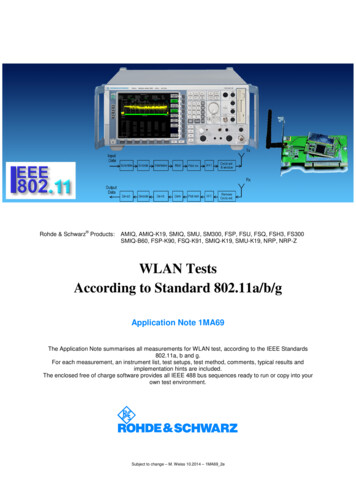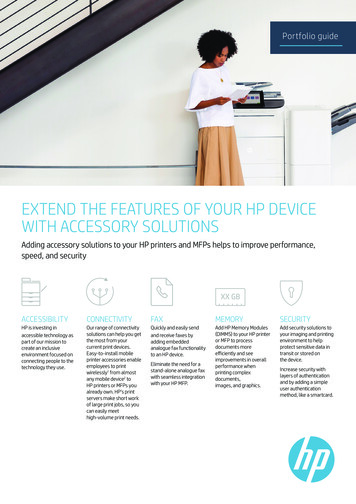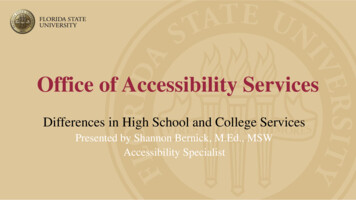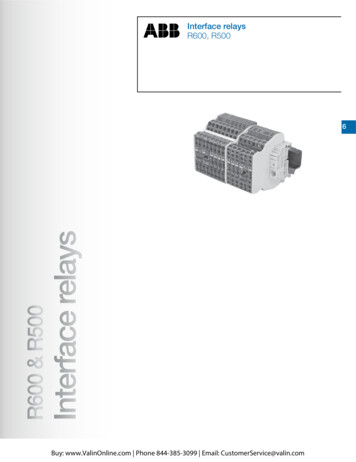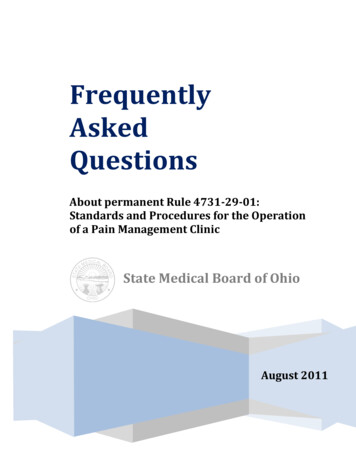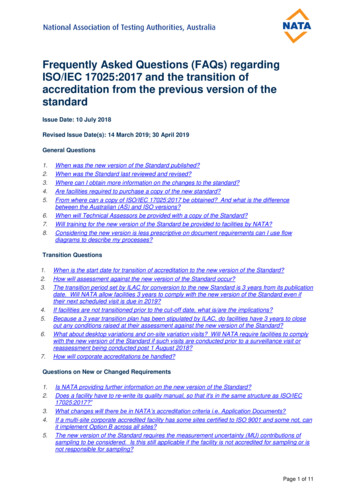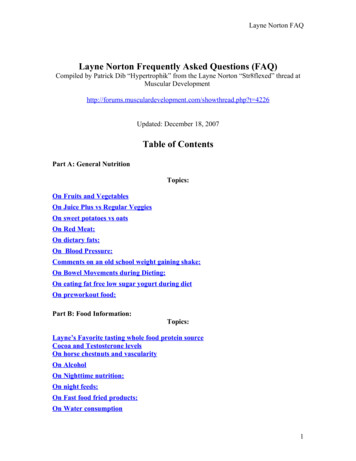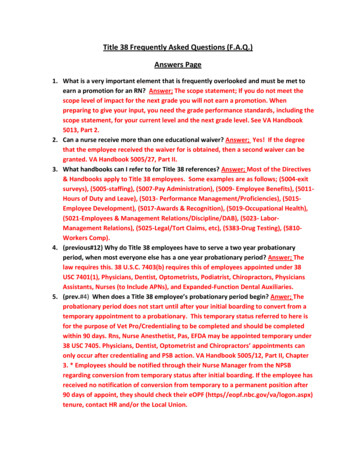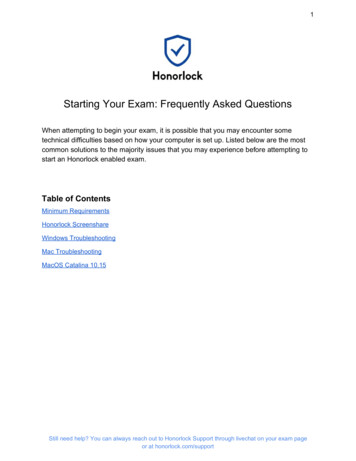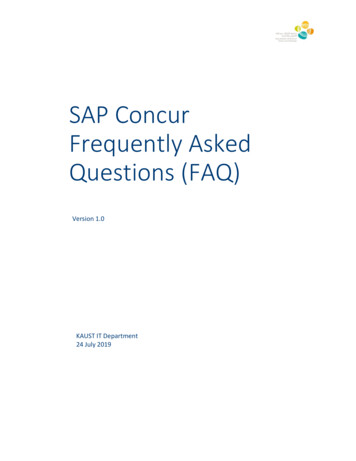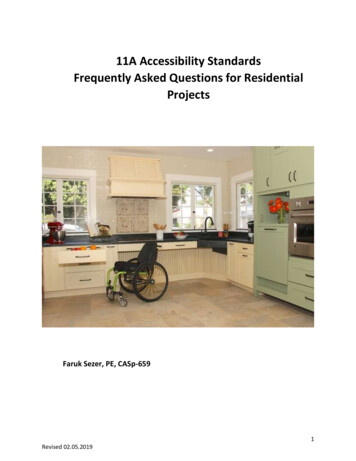
Transcription
11A Accessibility StandardsFrequently Asked Questions for ResidentialProjectsFaruk Sezer, PE, CASp-6591Revised 02.05.2019
PrefaceThis document is intended to provide information and technical guidance to assistowners, designers and developers with accessibility regulations of the State ofCalifornia in covered multifamily dwellings subject to 11A Standards.It is not the intent of this informal document, to provide any advice on theapplication of building code regulations to any specific conditions or project withtext or illustrations. The pictures and figures presented in this document areshown to illustrate and explain a specific code requirement. It is highlyrecommended that the actual governing code and regulations be consulted foraccessibility requirements applicable to any specific conditions or projects. Actualcompliance shall be verified during the plan check process.The user of this guideline is hereby advised to consult with a California licensedarchitect or a California Certified Access Specialist (CASp) for evaluation andapplication of accessibility regulations to any project under consideration.Note: Covered multifamily dwellings may be subject to the requirements of morethan one jurisdiction or law, which would require compliance with each law.Where federal, state, or local laws differ, the more stringent requirements isapplicable. For additional information, see the joint statement issued on April 30,2013 by the Department of Housing and Urban Development and the Departmentof Justice (www.hud.gov).2
1. Does 11A Housing Accessibility Standards require fully accessible units?No, the 11A Housing Accessibility requirements do not require fullyaccessible units. However, the requirements shall be easily adaptedby people with disabilities who require features of accessibility. Seedefinition of “Adaptable”.2. Does 11A Housing Accessibility Standards apply to existing buildingscontaining covered multifamily dwellings?Alterations, rehabilitation, or repair of covered multifamily dwellingsare not covered because the standards design and constructionrequirements only apply to new construction of buildings, built forfirst occupancy after March 13, 1991.However, a covered multifamily dwelling that has been constructedto comply with the law, cannot later be altered to make it noncompliant with the law.Additions of 3 or more apartment units, or four or morecondominiums are covered by the design and constructionrequirements3. Does 11A Housing Accessibility Standards apply to detached, single-familydwellings or duplexes?No, the 11A Housing Accessibility standards apply to all newlyconstructed covered multifamily dwellings, including but not limitedto: Apartment buildings with 3 or more dwelling units Condominiums with 4 or more dwelling units4. What is a public housing project?Public housing is a defined term under Chapter 2 of the CBC andLABC.Housing facilities owned, operated, or constructed by, for, or onbehalf of a public entity, including but not limited to state codesection.3
5. When is a covered multifamily project subject to public housingrequirements?Public housing is a defined term as per Chapter 2 of the LABC andCBC.If a state or local government enters into an agreement with aprivate party in order to provide housing, then the project shallcomply with public housing requirements.Examples of public housing projects include: Projects receiving the California Tax Credit Allocation Committee(TCAC) Projects receiving federal, state, or local funds to provide lowincome housing units. Programs that provide shelter for homeless people.Example of housing projects that are exempt from Public housingrequirements include: A project receiving a local government subsidy, in order toreplace windows and doors A program that requires a fund to remove asbestos from theproperty.See also the memo issued by DSA on May 22, 2017 in Public df6. Can you provide examples of “Newly-Constructed Covered multifamilydwelling” types?Newly-constructed covered multifamily dwellings as defined in 11AHousing Accessibility standards, include, but are not limited to, thefollowing CBC Chapter 11A Section [1102A]:I.Apartment buildings with 3 or more dwelling units includingtimeshare apartments not considered a place of publicaccommodation or transient lodging, as is defined in Health and4
II.III.IV.V.VI.VII.VIII.IX.X.Safety Code Section 19955 (a) and Chapter 2 of the CaliforniaBuilding Code.Condominiums with 4 or more dwelling units including timesharecondominiums not considered a place of public accommodation ortransient lodging as defined in Health and Safety Code Section 19955(a), and Chapter 2 of the California Building Code.Lodging houses, as defined in Chapter 2 of the California BuildingCode, used as a residence with more than 3 but not more than 5guest rooms.Congregate residences, as defined in Chapter 2 of the CaliforniaBuilding Code, with 3 or more sleeping units.Dwellings with 3 or more efficiency units, as defined in Chapter 2 ofthis code, or Section 17958.1 of the California Health and SafetyCode.Shelters for homeless persons, not otherwise subject to the disabledaccess provisions of the Division of the State Architect-AccessCompliance (DSA-AC).Dormitories, as defined in Chapter 2 of this code, with 3 or moreguest rooms as defined in Chapter 2 of the California Building Code.Timeshare dwellings with 3 or more units, not considered a place ofpublic accommodations or transient lodging as defined in Health andSafety Code Section 19955 (a), and Chapter 2 of the Californiabuilding Code.Other Group R occupancies in covered multifamily dwellings whichare regulated by the Office of the State Fire Marshal. See Section1.11.Public housing, as defined in Chapter 2 of this code is subject toprovisions of the Division of the State Architect (DSA-AC) in Chapter11B. Newly constructed covered multifamily dwellings, which canalso be defined as public housing, shall be subject to therequirements.7. Am I obligated to comply with federal accessibility requirements, inaddition to state and local jurisdiction accessibility standards?5
Yes, it is the responsibility of the Owner and/or applicant, to complyto federal accessibility requirement.8. Does federal housing accessibility requirements apply to newlyconstructed covered multifamily dwellings? If yes, what agency reviewsplans for federal accessibility requirements?Yes, federal agencies do not have the mechanism to review plans.The burden of compliance rests with the person or persons whodesigned and constructed the covered multifamily dwellings.9. What kind of housing is covered by the 11A Housing Accessibilityrequirements?Covered multifamily dwelling units with three or more apartmentunits or four or more condominiums in one building, that have beendesigned and constructed since March 13, 1991. This includes, butare not limited to condominiums, townhouses, apartment buildings,vacation or other time share units, assisted living projects, publichousing projects, dormitories, shelters for homeless persons,dwellings with 3 or more efficiency units, lodging houses10. Do the 11A Housing Accessibility standards apply to Carriage units.No, carriage units are exempt from 11A accessibility requirements aslong as it meets the definition of a Carriage unit per Chapter 2 ofLABC.CARRIAGE UNIT. [HCD 1-AC] A dwelling unit with living space on oneor more floors, immediately above a Group U, private garage orgarages. The footprint of the garage or garages is used as thefootprint for the remaining floor or floors of the units above, and thegarage level, contains no Habitable space.Note: Dwelling units located over a common garage shall not beconsidered carriage units.6
11. I am proposing five new single story apartment units. Shall all of theunits need be accessible?All units are covered multifamily dwellings and all the units areground floor units, therefore, all five units shall be accessible andadaptable. Apartments with 3 or more units and condominiums with4 or more units are subject to 11A STD’s [1102A].12. Can an elevator in a building serve just some select units?An elevator that is installed in a building and that serves one or moreunits makes the building an elevator building. All units in an elevatorbuilding must comply with 11A housing accessibility standards[1104A].An exception to this general rule, occurs when an elevator isprovided only as a means of creating an accessible route to dwellingunits on a ground floor. In that case, the elevator is not required toserve dwelling units on floors that are not ground floors, and thebuilding is not considered to be an elevator building. Only the groundfloor units served by this elevator are required to meet the guidelinerequirements.7
13. Are the newly constructed, common use areas, such as, common poolsand gymnasium, required to be accessible under 11A Housing Accessibilitystandards provided that such uses are for residents and their guests?If the original building built contains multifamily units and is built forthe first occupancy before March 13, 1991, then there are nocovered multifamily dwellings on site, therefore, newly constructedcommon areas are not required to be accessible under 11A HousingAccessibility standards [1101A.2].If however, the building is built for the first occupancy after March13, 1991, then there are covered multifamily dwelling on site,therefore, newly constructed common areas are required to beaccessible [1101A].14. If new covered multifamily dwellings are added to housing that wasconstructed before March 13, 1991, do the public or common use areashave to be retrofitted to be accessible?No, although new covered multifamily dwellings constructed afterMarch 13, 1991 have to comply with the Act's access requirements,public and common use areas constructed before that date do nothave to be modified to comply with the 11A Housing Accessibilitystandards. This is due to existing common use areas built prior to1991 were never intended to be accessible when built [1102A.2].15. There is an existing one story duplex building built prior to 1991 andproposed work is to install three new units on top of an existing duplexbuilding. Shall any of the units be accessible?Proposed work is an addition three units apartment building.Therefore, all three units shall have an accessible route and shall beadaptable and accessible [1101A.1] [1102A.2].8
16. Can a unit have a raised or a sunken living room, and still be compliantwith the 11A Housing Accessibility requirements?Yes, as long as the raised, or sunken living room is located on anaccessible route [1128A].17. I am proposing a 3 story, 13 units, townhouse style apartment building.On the ground level there will be a private garage, and on the secondfloor there will be kitchen and a bathroom, and on the 3rd level there willbe bedrooms. Do I need to provide accessible units?Yes. This is a building with Multistory dwelling units without anelevator.At least 10% of units shall be in compliance that is 10% of 13.Therefore, 2 units shall be provided that shall comply [1102A.3] withthe following: The primary entry shall be on an accessible route At least one powder room or bathroom shall be on the primary level All rooms or spaces located on the primary entry level shall be onaccessible route9
Common use areas shall be on an accessible route [1102A.3]. Exeption: Carriage units as defined in Chapter 2 and regulated onlyby the Department of Housing and Community Development asreferenced in Section 1.8.2.1.2.18. Are the additions subject to 11A housing accessibility standards?Additions are subject to 11A housing accessibility standards wherethe addition itself meets the definition of a Covered multifamilyDwelling.For example: If the site has an existing 2 units building and theproposed work is to add 3 single story units, then subject 3 unitsshall be accessible and adaptable [1102A.2].19.For the same example above #18, How many units shall be accessible andadaptable if said newly added units are two story units( Multistory units)?Only 10% of three, that is one unit shall be accessible and adaptablesince the building is non elevator building and units are Townhousestyle units [1102A.3].20. Proposed work is to have brand new eight duplexes (two units in eachbuilding) and there will be common use areas, such as, a swimming pool,recreational room, and Gym for residents and their guest. Shall commonuse areas be accessible?Single family units and duplex units, are not covered multifamilyunits, therefore, common use areas serving duplex units are exempt10
from the 11A standards as long as the common use areas are usedexclusively by residents and their guests [1102A] [1101A].21.There is an [e] commercial office building and proposed work is to convert[E] office space into a 10 unit apartment building. Shall all 10 units beaccessible?No. [E] Building is built as office for the first occupancy and it is not anewly constructed covered multifamily dwelling therefore conversionof [e] office to an apartment is not subject to 11A Standards unlessentire inside walls are demolished and exterior is preserved [1101A.1item #1&5].22. Do the CBC accessibility requirements apply to alteration or renovation ofproperties?The building standards contained in CBC 11A do not apply to thealteration, repair, rehabilitation or maintenance of multifamilydwellings constructed for first occupancy prior to March 13, 1991.However, a covered multifamily dwelling that has been constructedto comply with the law cannot later be altered to make it noncompliant with the law. [1102A.2].23. How are 10% of units calculated per site? For example, having sixbuildings and each building has 4 units, totaling 24 units on site? Does the10% rule apply to a site or is it per building?The 10% rule applies to a site and is not per building. In the caseabove, only 10% of 24 which is 3 units, shall comply with 11AStandards [1102A.3].24. What are the requirements for multi-story building containing multi-storyunits where building contains an elevator?Multi-story dwelling units contained in buildings with elevators shallcomply with following. [1102A.3.2].11
25. I am proposing 2 story apartment building. On the ground level there willbe a common garage and on the second floor there will be apartmentunits. Do I need to install an elevator from garage level to the groundlevel of the units located on the second floor?Yes. All units shall be served by an accessible route [1104A.2].12
26. I am proposing new roof top deck. Do I have to extend the elevator toroof deck even though I am providing open space on other location of theproperties?When provided, common use areas and facilities in coveredmultifamily housing developments shall be accessible to persons withdisabilities. Common use facilities include, but are not limited to,lobbies, toilet and bathing facilities, laundry facilities, communityrooms, clubhouses, health and fitness facilities, game rooms andportions of common use tenant storage. All entrances, doors, fixturesand controls shall be on an accessible route.27. Do I have to include an elevator that goes to the roof deck if the roofdeck is only used for mechanical access purposes?No, an elevator is not required to a roof deck unless the roof deck isused as common open space [1101A.1].28. Is a lift permitted as a part of accessible route?Yes, a lift is permitted to be a part of an accessible route. Onceprovided it shall comply with size, landing, standby power ,opennessdoor and signage requirements [1124A.11].13
29. Shall a new swimming pool that is added to existing apartment buildingbe accessible?If the original building is built for the first occupancy prior to March13, 1991, the building is not a covered multifamily dwelling andproposed pool is not subject to Standards.If however the building is built after 1991, The building is a coveredmultifamily dwelling and proposed pool shall be accessible [1101A],[1102A.2].Note: Any use open to the public is subject to provisions of theDivision of the State Architect (DSA-AC) in Chapter 11B.30. Are garbage dumpsters required to be on an accessible route under CBC11A?Yes, garbage dumpster shall be on accessible route [1127A.1].31. How many parking spaces shall be accessible in a housing projects?Accessible parking spaces shall be provided at a minimum rate of 2%of units, or 2% of the assigned parking spaces, whichever larger.For example, if the site has 50 units and 75 parking spaces, 2% of 75is 1.5. The calculated fractional spaces shall be round up, therefore aminimum of 2 accessible spaces are required, one of which shall beVan Accessible [1109A.3, 1109A.4, 1109A.8.6].32. Does the code require additional parking spaces for visitors or guests? Ifso, what is the minimum required parking rate?If the site has assigned parking spaces for residents as well as visitorparking spaces, accessible parking spaces are required for each type.Parking rate for the visitors are at 5%.For example; if the site has 75 assigned parking spaces and 8 visitorparking spaces, total of 2%of 75 equal to 2 spaces for the residents,and 5% of 8 equal to 1 space for visitor is required, totaling 3accessible spaces that are required for the site [1109A.3, 1109A.4,1109A.5].14
33. If I am providing a valet parking service, am I still required to provide 2%accessible parking spaces for covered multifamily dwellings?Yes, a minimum of 2% of the parking spaces that serve covereddwelling units must be accessible34. I am planning to convert my existing apartment building into acondominium and city planning requires additional visitor parking spaces.Do I have to provide additional accessible visitor parking spaces?If the original building is built for the first occupancy after March13,1991, the building is covered multifamily dwelling and additionalvisitor accessible parking spaces are required with a rate of 5%[1109A.5].35. Is there any standards in 11A for location of parking spaces?Yes, the standards require that parking spaces shall be on theshortest accessible route and shall be located so that persons withdisabilities are not compelled to wheel or walk behind other carsother than their own [1109A.7].In addition, accessible parking spaces shall have vertical clearance,slope and size requirements [1109A.8.1, 1109A.8.3, 1109A.8.4,1109A.8.5].36. How many van accessible spaces are required?In a housing project, one per eight accessible spaces, but not lessthan one accessible space, shall be van accessible. Loading andunloading space shall be on the right, passenger side [1109A.9.8.6].37. If the proposed work is a mixed use project, how is parking countcalculated?Parking shall be calculated separetly for each use.38. What is the height requirements for a vertical clearance in a garage orcarport?15
All entrances, exits, and vehicular passageways, to and from requiredaccessible parking spaces within parking facilities, shall have aminimum vertical clearances of 8 feet 2 inches (98”) from the floor tothe lowest projection of the ceiling. This 98” shall be clear of anyplumbing pipes, sprinkler head or obstruction at ceiling [1109A.8.1].39.What are the accessible parking size requirements in residentialapartment projects? Single spaces shall be 14 feet (4267 mm) wide minimum, and shallprovide a 9-foot (2743 mm) wide parking area and a 5-foot (1524mm) wide loading and unloading access aisle. Access aisles shallbe permitted to be located on either side of the vehicle and shallextend the full required length of the parking spaces they serve[1109A.8.5],[1109A.8.6]. When more than one space is provided, two 9-foot (2743 mm)wide parking spaces may be lined on each side of a 5-foot (1524mm) wide loading and unloading access aisle. The minimum length of each parking space shall be 18 feet (5486mm). The loading and unloading access aisle shall be marked by aborder painted blue. Note: See Figure 6 from 11A-2A, 11A-2B and11A-2C of building code.16
40. Are there any signage requirements for parking?Each accessible parking space shall be identified with signage andsurface markings in accordance with Sections [1109A.8.8.1] and[1109A.8.8.2].However, when assigned parking is provided, signage shall not berequired [1109.4].41. What is the minimum accessible route requirements required forresidential projects?Walkways and sidewalks subject to 11A standards shall be aminimum of 48” in width, except those walkways serving the unitwhich shall be a minimum of 36” [1113A].42. What is the difference between a walk and a ramp?A. Ramp is a walking surface that has a running slope that is greaterthan 1 unit vertical in 20 units horizontal. (5% slope), and less than 1unit vertical in 12 units horizontal( 8.33 % slope).B. Ramp requires a top and bottom landing and handrail extensions oneach side additionally, there are requirement for ramp width and runheight [1114A].17
43. Can you provide some example of ramp dimensions?44. What is the minimum headroom clearance required on an accessibleroute?80” is the minimum headroom clearance required [1116A.2].Note: See Chapter 10 Means of Egress for additional requirements.45. Is a Spa covered under 11A for Covered multifamily dwellings?A spa meets the definition of a swimming pool per Chapter 2 of theLABC as it states, “ Any structure intended for swimming,recreational bathing, or wading that contains water over 24” deep ”therefore, the spa shall comply with 11A Standards [1141A][Definition].46. What are the requirements for water closet flush controls in bathrooms/powder rooms within accessible and adaptable units?18
There are no standards for water closet flush controls withinadaptable units.47. Where should the required clear openings at doors be measured?With the door open 90 degrees, the clearance is measured betweenthe face of the door and the opposing doorstop. The primaryentrance door to dwellings, and public and common use doors, mustbe 36” minimum in width and have a 32-inch minimum clearopening. Passage doors within a dwelling must have a nominal 32inch clear opening [1126A.1], [1132A].48. If a bathroom has more than one entrance door, must all doors complywith access requirements?Yes, all doors that are for user passage must meet accessrequirements and provide a nominal 32-inch clear opening [1126A.1],[1132A].49. Are electrical receptacles switches and control heights, within reachrange specified in the code?Yes. Receptacles, switches shall be accessible and within reach rangeof 15” minimum measured from bottom of the outlet box to thefinish floor or working platform, and 48” maximum measured fromthe top of the receptacle outlet box [1142A].19
If the reach is over a physical barrier or an obstruction (for example,a kitchen base cabinet), receptacles shall be located within the reachranges specified in Section 1138A.3.50. What is the maximum threshold at the entrance of an adaptable showerwithin a covered multi-family unit?Threshold at a shower is not required, but may be provided. When athreshold is used, it shall be a maximum of 2 inches in height andhave a beveled or sloped angle not exceeding 1 unit vertical in 2 unitshorizontal.Thresholds 1/2 inch (12.7 mm) or less in height may have a beveledor sloped angle not exceeding 1 unit vertical in 1 unit horizontal[1134A.6 item#5].22112 inches11½”51. Is a doorbell required at primary entry door of a unit? If required, can itbe the type that is a battery operated wireless doorbell?Every primary entrance to a covered multifamily dwelling unit shallbe provided with a door buzzer, bell, chime or equivalent. Theactivating mechanism shall be mounted a maximum of 48 inches(1219 mm) above the floor and connected to permanent wiring[1132.A10].52. What are the door maneuvering space requirements within a coveredmultifamily dwelling units’ interior doors?Maneuvering clearances at interior doors shall provide a minimumlength on both sides of the door of at least 42 inches (1067 mm),measured at a right angle to the plane of the door in its closedposition [1132A.5].There shall be a minimum of 18” at strike edge maneuvering space atdoors [1132A.5.2].20
Exception: A 39-inch (991 mm) length is acceptable at interior doorswhen a minimum clear opening width of 34 inches (864 mm) isprovided [1132A.5].53. What are the basic requirements for kitchens within covered multifamilydwellings? Kitchen shall be on an accessible route [1133A.1]. A clear space of 30”x48” parallel approach shall be provided at therange or cooktop [1133A.2]. A clear space of 30”x48” parallel or forward approach shall beprovided at sink, fixtures, and appliances [1133A.2]. The clear space shall be center lined with each sink, fixture andappliances [1133A.2].54. What is the max allowable kitchen counter height?Max kitchen counter height is 36 inches measured from above thefinish floor [1138A.3.2 item#2].55. Shall removable base cabinets be removable under sink and work space?Yes, sinks and work surfaces shall be provided with knee and toespace. Base cabinets (including toe board and shelving), directlyunder kitchen sinks and work surfaces, shall be Removable withoutthe use of specialized tools or specialized Knowledge in order to21
provide knee and toe space. The finish floor beneath kitchen sinksand work surfaces shall be extended to the wall [1133A.3].56. What are the requirements for knee and toe spaces?Knee and toe space, when required by Section 1133A, shall comply withSection 1138A.2 and the following: The knee and toe space shall be clear and unobstructed, orremovable base cabinets in compliance with Section 1133A.3 shallbe provided. The knee and toe space shall be 30 inches (762 mm) wide minimum,centered on the sink, countertop, or appliance. A clear floor space shall not extend into the knee and toe spacemore than 19 inches (483 mm). Water supply and drain pipes under kitchen sinks shall be insulatedor otherwise covered to protect against contact. There shall be nosharp or abrasive surfaces under kitchen sinks.57. How much space do I need for kitchen and work space within coveredmultifamily dwellings? A minimum linear length of 30 inches (762 mm) of countertop shallbe provided for the kitchen sink installation. A minimum linear length of 30 inches (762 mm) of countertop shallbe provided for a work surface.22
Sinks and work surfaces may be a single integral unit a minimum of60 inches (1524 mm) in length, or be separate components.Exception: Two 15-inch (381 mm) wide minimum breadboards maybe provided in lieu of the required 30 inches (762 mm) of countertopwork surface [1133A.4].58. How many bathroom shall be in compliance with 11A accessibilitystandards if more than one bathrooms are provided?There are two options; [1134A].Option#1 requires all bathroom to comply with 11A partial liststandards.Option #2 requires at least one bathroom to comply with 11A full liststandards. The first bathroom shall have the following: Sufficient maneuvering space within the room. Bathtubs and shower complying with 1134A.5&1134A.6. Water closets complying with section 1134A.7. Lavatories, vanities, mirrors and towel fixtures comping withSection 1134A.8. Accessible route shall be provided into and throughout additionalbathrooms. If door is provided, door shall have 42” maneuvering space. 18” of strike edge clearance at pull side. Switches, outlets, and controls to be within reach range per1142A.23
Reinforced walls to allow for the future installation of grab bar.The additional restrooms shall comply with items 8 through 12 persection 1134A.1 which include: An accessible route shall be provided into and throughoutadditional bathrooms. If door is provided, door shall have 42” maneuvering space 18” of strike edge clearance at pull side. Switches, outlets, and controls to be within reachable range per1142A. Reinforced walls to allow for the future installation of grab bar.59. What is the minimum clear space required for an accessible bathtubwithin a covered unit?There shall be a minimum clear floor space of 48 inches parallel by 30inches perpendicular (1219 mm by 762 mm) to the side of a bathtubor bathtub- shower combination. The purpose is to provide for themaneuvering of a wheelchair and transfer to and from the bathingfacilities. The controls shall be on the wall at the foot of the bathtub.The edge of the clear floor space shall be flush with the control wallsurface [1134A.5].24
60. Can door swing into clear space required for other fixtures?Yes, the door can swing over other clear spaces required for eachfixture within accessible bathrooms, and powder rooms [1134A.4].61. Can a water closet, project into required 30”x48” that is clear space thatis required for the accessible tub?Toilets and cabinets under lavatories are NOT permitted to projectinto clear space required for the tub. However, lavatories withoutcabinets can project max of 19” into the clear space. [1134A.5]25
62.What are minimum accessible shower sizes allowed within coveredmultifamily dwelling units?When one or more shower stalls are provided within the same dwellingunits, at least one shower stall complies with one of the followingrequirements [1134A.6]: The shower stall shall measure at least 42 inches wide by 48 inchesdeep with an entrance opening of at least 36 inches; or The shower stall shall measure at least 30 inches deep by 60 incheswide with an entrance opening of at least 60 inches. A water closetmay project a maximum of 12 inches into the opening, provided thata minimum of 36 inches clear space is maintained between the watercloset and the shower wall, as illustrated in Figure 11A-9L or;26
Other shower stall configurations shall measure at least 36 inchesdeep by 60 inches wide with an entrance opening of at least 36inches (
Timeshare dwellings with 3 or more units, not considered a place of public accommodations or transient lodging as defined in Health and Safety Code Section 19955 (a), and Chapter 2 of the California building Code. IX. Other Group R occupancies in covered multifamily dwellings which are regul
